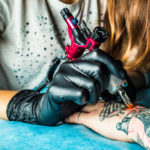 Shutterstock
Two generations ago, tattoos were relatively scarce, and primarily only among a few types of people, but their presence has increased from 5% in 2003 to 12% in 2016, and half of those with tattoos have more than one, all without really knowing the safety and regulation of the inks used for tattoos and permanent makeup.
Shutterstock
Two generations ago, tattoos were relatively scarce, and primarily only among a few types of people, but their presence has increased from 5% in 2003 to 12% in 2016, and half of those with tattoos have more than one, all without really knowing the safety and regulation of the inks used for tattoos and permanent makeup. Shutterstock
Shutterstock
Two generations ago, tattoos were relatively scarce, and primarily only among a few types of people, but their presence has increased from 5% in 2003 to 12% in 2016, and half of those with tattoos have more than one, all without really knowing the safety and regulation of the inks used for tattoos and permanent makeup.
In the US, 40% of 16-34-year-olds have at least one tattoo. Though the Navy and Marines have long had tattoos, they recently had to get more lenient about volume, because so many young people had them.
Since they are created by injecting colored inks into the skin and are intended to be permanent, there has been ongoing concern about long term exposure to the chemicals injected and, possibly, to their degradation products.
There is no national rule on tattoos or permanent makeup products (semi- or permanent tattoos that resemble make-up) but all states have laws prohibiting minors from getting them while 38 will allow it with parental permission. Until recently, some states don't even require that tattoo artists are certified, but they contain dozens of different colorants and 100 additives. The pigments used are not specifically produced for tattoo and permanent makeup applications, and generally contain impurities. Over 80% of the colorants in use are organic chemicals and more than 60% of them are azo-pigments, some of which can release carcinogenic aromatic amines. This can be the result of a degradation process in the skin, particularly under solar/ultra violet radiation exposure or laser irradiation.
Because there is no systematic data gathering for adverse effects on human health, data on complications (mainly of dermatological nature) is not well known. Bacterial infections may happen in up to 5% of people with tattoos, especially when the tattooing was carried out in unhygienic settings.
As the market grows, the shady unlicensed and unhygienic practitioners will fade away, and Good Manufacturing Practices for manufacturing tattoo/permanent makeup inks will occur. Then there will be true risk assessment and analytical methods. In Europe, the Joint Research Centre has issued its final report on tattoo safety.


